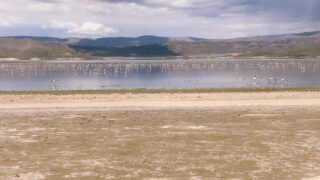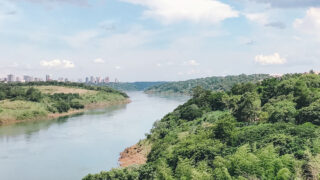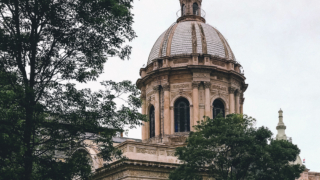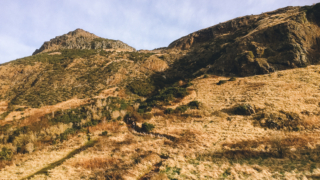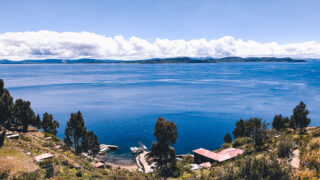When I planned my trip to Vietnam Bacson Valley was top of my list of things to do in Vietnam. I decided to do the second-best thing, Sapa. And how wrong I was to think that three-days of trekking the Muong Hoa Valley to a homestay shouldn’t be number one.
The town of Sapa appeared moody at first. Once the fog lifted the true beauty of the Muong Hoa Valley came to light. The yellow and green colourations of the rice fields and the paths through thick bamboo forest make you realise that you are in a faraway land.
During the three-days trekking Sapa and a night in a homestay, we learnt about local customs, how to cook Vietnamese cuisine, and sang songs with the host family whilst pouring down shots of firewater.
Trying to figure out what to expect, to book a tour or trek without a guide, how much it costs, and what on Earth fire water is? Read on to find out.
Check out my guide on how to travel from Hanoi to Sapa by bus and train.
Post Contents
WHAT TO EXPECT FROM THREE-DAYS OF TREKKING THE MUONG HOA VALLEY TO A HOMESTAY
Difficulty: Intermediate
Duration: Day 1 – 4h, Day 2 – 7h Day 3 – 4h
Bear in mind that I visited in February when weather conditions are not ideal, but I had a great time nonetheless.
Day 1 │ Visiting Cat Cat Village.
On day one the group of six set off at 2 pm. The start of the hike wasn’t promising with fog lying thick over Sapa. We reached the cobblestoned streets of Cat Cat village after a short 3km hike past chickens, pigs, and Black H’Mong tribespeople selling handicrafts, and traditionally weaved and dyed black hemp clothing. There is an entrance fee to the village of VND 50,000 (2018).
The visibility had still not improved drastically when we reached a bamboo bridge guiding us past a waterfall, adding to the mysterious atmosphere. This is when we came across what must be the most impressive swing/ makeshift fairy wheel I have ever seen.
On a sunny day, the hike is graced with beautiful views of the green hills covered in rice fields. In summer Cat Cat village is the most beautiful surrounded by fields of blossoming flowers.

After exploring the village, we returned to Sapa to spend the night in private rooms at a hostel. The first day ended with traditional Vietnamese food, card games, and blurring out some karaoke tunes.
Day 2 │ Trekking to Ta Van Village.
On the second day we had an at 8 am start with breakfast followed by trying on rubber boots. Turns out being in a country where most people are my height, doesn’t mean that tour operators cater for small feet.
A group of local women dressed in colourful traditional weaved outfits will join the group in the morning to assist hikers at the muddiest parts of the way. I found the hand holding was doing more harm than good and after gratefully declining the help I was left alone.
Trekking Sapa isn’t difficult although the start of the trail was more of a mud bath than a trail. A Black H’Mong Tribes woman was guiding the way in slippers with a baby on her back, making us look like fools slipping and falling into the mud.
Once the up and downhill trail led us out of the woods, away from the muddy path we could relax and enjoy the bright sunshine and beautiful green and yellow scenery.

The final stretch to Ta Van Village was mostly flat. The trail leading to the lunch place lead us past piglets and wooden houses.
Once we reached the village the local women hiking with the group revealed what was hidden in the weaved baskets on their backs. Handcrafts and souvenirs to purchase in exchange for their help.
Once the haggling was out of the way and the women made their way home, we could sit down to enjoy lunch before heading to the homestay.
The Homestay.
At 3 pm we reached our Homestay – Po. The host family taught us how to cook spring rolls and shared their homemade rice wine.
The sleeping arrangement was a few mattresses aligned on the floor of the spacious second floor, with single ones away from the crowd. Plenty of heavy blankets were provided to keep warm.
To my surprise wifi was available and my plans for staying offline drowned quickly in peer pressure.
Day 3 │ Bamboo Forest Trekking.

The morning began with an 8 am pancake breakfast on the terrace marvelling at the sun rising from behind the mountains. The stunning limitless view over the Muong Hoa Valley and the rice plantations carved into the hills is one that cannot easily be topped.
The start of the final day’s hike was flat and easy. The trail led through the thick bamboo forest. A stray dog joined for part of the journey down steep slippery stones, over bridges past small waterfalls, and Ban Y Linh Ho Village.

At the end of the hike, we had lunch at a local restaurant where we enjoyed one last panoramic view of the green hills before returning to Sapa.
THREE-DAYS OF TREKKING THE MUONG HOA VALLEY TO A HOMESTAY BY TOUR
Tours can be booked in Sapa or in advance in Hanoi. Shop around for the best price and tour since there are many different options.
The advantage of booking tours locally is not only the price. The weather can change drastically from day to day allowing you to plan around bad conditions.

How Much Does It Cost?
Prices for tours start from $70 include the accommodations, food, rubber boots, and the guide. Booking tours online can only be described as a mind-blowing rip-off.
Excluded is the entrance fee to Cat Cat Village and drinks at the homestay.
THREE-DAYS OF TREKKING THE MUONG HOA VALLEY TO A HOMESTAY ON YOUR OWN

Adventurer at heart or simply want to save some money? There is no need to book a tour. If you wish to hike for multiple days, I advise you to book a homestay in Sapa. During off-season the likelihood of being able to turn up in the villages and find a homestay is high but in peak season it’s not worth the risk.
The only exception is Fansipan Peak. The three-day trek is more difficult and cannot be completed without a guide.
MY THOUGHTS AND RECOMMENDATIONS
The three-days tour of trekking the Muong Hoa Valley to a homestay was great and the nature extraordinary. However, I wouldn’t book a tour again.
I would have preferred to spend the first night somewhere else than Sapa and hike for longer on the last day. I suggest trekking deeper into the Muong Hoa Valley or add a day. Remember, there are many tours to different places in the area to pick from.
BEST TIME OF YEAR TO TREK SAPA
Want to make your experience special? At the start of Spring, the Singing Festival in the Ta Phin Village takes place. Expect colourful costumes and Red Dao brides and grooms dancing through the village streets.

The best time to visit Sapa is between September to November and March to May. During the dry period prices peak and accommodations should be arranged in advance.
April to May is when the colouration of the rice fields is most radiant, and most farming activity takes place.
Throughout the coldest time of year, December to February snow is not uncommon.
Trying to avoid high season wherever I go, I visited Sapa in February. Although cold and several layers were required, the last two days of trekking were sunny and hot.
WHAT TO PACK FOR THREE-DAYS OF TREKKING THE MUONG HOA VALLEY TO A HOMESTAY
The mountain weather like everywhere is temperamental. Come prepared with layers, a rain poncho, warm jacket, warm clothes to sleep in, hiking boots, change, sun cream, and mosquito repellent. I didn’t need the later but better safe than sorry.
Did I do a good job of sharing my love for trekking Sapa? Also, did I mention that the hosts love to share a shot of firewater? Still no clue what it is? The official name rice wine probably means more to you.
Now go ahead and explore! Try not to lose your towel.

















